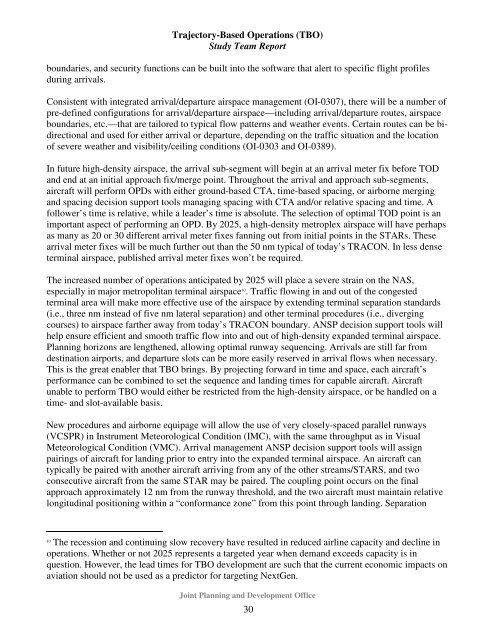Trajectory-Based Operations (TBO) - Joint Planning and ...
Trajectory-Based Operations (TBO) - Joint Planning and ...
Trajectory-Based Operations (TBO) - Joint Planning and ...
You also want an ePaper? Increase the reach of your titles
YUMPU automatically turns print PDFs into web optimized ePapers that Google loves.
<strong>Trajectory</strong>-<strong>Based</strong> <strong>Operations</strong> (<strong>TBO</strong>)<br />
Study Team Report<br />
boundaries, <strong>and</strong> security functions can be built into the software that alert to specific flight profiles<br />
during arrivals.<br />
Consistent with integrated arrival/departure airspace management (OI-0307), there will be a number of<br />
pre-defined configurations for arrival/departure airspace—including arrival/departure routes, airspace<br />
boundaries, etc.—that are tailored to typical flow patterns <strong>and</strong> weather events. Certain routes can be bidirectional<br />
<strong>and</strong> used for either arrival or departure, depending on the traffic situation <strong>and</strong> the location<br />
of severe weather <strong>and</strong> visibility/ceiling conditions (OI-0303 <strong>and</strong> OI-0389).<br />
In future high-density airspace, the arrival sub-segment will begin at an arrival meter fix before TOD<br />
<strong>and</strong> end at an initial approach fix/merge point. Throughout the arrival <strong>and</strong> approach sub-segments,<br />
aircraft will perform OPDs with either ground-based CTA, time-based spacing, or airborne merging<br />
<strong>and</strong> spacing decision support tools managing spacing with CTA <strong>and</strong>/or relative spacing <strong>and</strong> time. A<br />
follower’s time is relative, while a leader’s time is absolute. The selection of optimal TOD point is an<br />
important aspect of performing an OPD. By 2025, a high-density metroplex airspace will have perhaps<br />
as many as 20 or 30 different arrival meter fixes fanning out from initial points in the STARs. These<br />
arrival meter fixes will be much further out than the 50 nm typical of today’s TRACON. In less dense<br />
terminal airspace, published arrival meter fixes won’t be required.<br />
The increased number of operations anticipated by 2025 will place a severe strain on the NAS,<br />
especially in major metropolitan terminal airspace 10 . Traffic flowing in <strong>and</strong> out of the congested<br />
terminal area will make more effective use of the airspace by extending terminal separation st<strong>and</strong>ards<br />
(i.e., three nm instead of five nm lateral separation) <strong>and</strong> other terminal procedures (i.e., diverging<br />
courses) to airspace farther away from today’s TRACON boundary. ANSP decision support tools will<br />
help ensure efficient <strong>and</strong> smooth traffic flow into <strong>and</strong> out of high-density exp<strong>and</strong>ed terminal airspace.<br />
<strong>Planning</strong> horizons are lengthened, allowing optimal runway sequencing. Arrivals are still far from<br />
destination airports, <strong>and</strong> departure slots can be more easily reserved in arrival flows when necessary.<br />
This is the great enabler that <strong>TBO</strong> brings. By projecting forward in time <strong>and</strong> space, each aircraft’s<br />
performance can be combined to set the sequence <strong>and</strong> l<strong>and</strong>ing times for capable aircraft. Aircraft<br />
unable to perform <strong>TBO</strong> would either be restricted from the high-density airspace, or be h<strong>and</strong>led on a<br />
time- <strong>and</strong> slot-available basis.<br />
New procedures <strong>and</strong> airborne equipage will allow the use of very closely-spaced parallel runways<br />
(VCSPR) in Instrument Meteorological Condition (IMC), with the same throughput as in Visual<br />
Meteorological Condition (VMC). Arrival management ANSP decision support tools will assign<br />
pairings of aircraft for l<strong>and</strong>ing prior to entry into the exp<strong>and</strong>ed terminal airspace. An aircraft can<br />
typically be paired with another aircraft arriving from any of the other streams/STARS, <strong>and</strong> two<br />
consecutive aircraft from the same STAR may be paired. The coupling point occurs on the final<br />
approach approximately 12 nm from the runway threshold, <strong>and</strong> the two aircraft must maintain relative<br />
longitudinal positioning within a “conformance zone” from this point through l<strong>and</strong>ing. Separation<br />
10<br />
The recession <strong>and</strong> continuing slow recovery have resulted in reduced airline capacity <strong>and</strong> decline in<br />
operations. Whether or not 2025 represents a targeted year when dem<strong>and</strong> exceeds capacity is in<br />
question. However, the lead times for <strong>TBO</strong> development are such that the current economic impacts on<br />
aviation should not be used as a predictor for targeting NextGen.<br />
<strong>Joint</strong> <strong>Planning</strong> <strong>and</strong> Development Office<br />
30
















